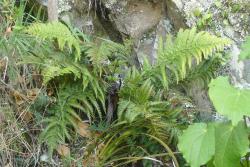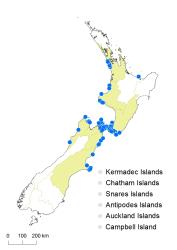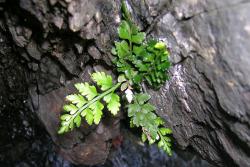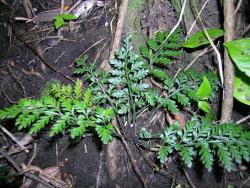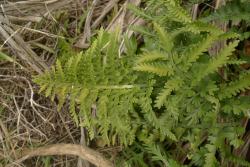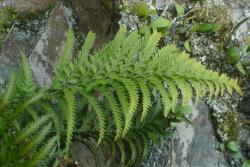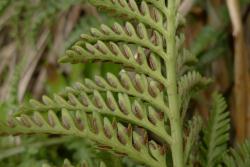- ≡ Asplenium terrestre subsp. maritimum Brownsey, New Zealand J. Bot. 15: 74 (1977)
- = Asplenium flaccidum var. littoralis Dobbie, New Zealand Ferns ed. 3, 302, f. 102a (1931) – as var. litoralis and var. literoralis
Rhizome scales 5–30 mm long, 1–3 mm wide. Fronds 40–670 mm long. Stipes 10–280 mm long. Laminae 1–2-pinnate-pinnatifid, ovate or elliptic or broadly ovate or broadly elliptic, abruptly narrowed to a pinnatifid apex, 20–420 mm long, 15–280 mm wide, mid- to dark green on both surfaces, thick and fleshy. Primary pinnae in 2–25 pairs below pinnatifid apex; proximal pinnae and those at mid-lamina ovate or narrowly ovate or narrowly oblong; the longest 5–200 mm long, 5–55 mm wide, apices obtuse or acute or acuminate. Secondary pinnae gradually decreasing in length along each primary pinna to the distal end, or all more or less equal in length decreasing only at the distal end; the longest proximal secondary pinnae ovate or elliptic or obovate, 4–45 mm long, 3–13 mm wide; the distal secondary pinnae straight, 2–10 mm long, 1.5–2.5 mm wide, apices acute. Indusia 2–7 mm long.
Asplenium appendiculatum subsp. maritimum is distinguished from subsp. appendiculatum by its coastal habitat, thicker and fleshier fronds, secondary pinnae that decrease only slightly along the primary pinnae, and sometimes by its broader laminae.
It occupies a similar coastal habitat to A. flaccidum subsp. haurakiense, although the two do not overlap in their distributions; subsp. haurakiense usually has an enlarged basal acroscopic secondary segment, which is markedly larger than the adjacent segment, whereas in A. appendiculatum subsp. maritimum the secondary pinnae decrease gradually in size from the proximal to distal end of each primary pinna. The spores of the two taxa are also markedly different (see Brownsey 1977b; Large & Braggins 1991).
North Island: Auckland, Volcanic Plateau, Taranaki, Southern North Island.
South Island: Western Nelson, Sounds-Nelson, Marlborough, Canterbury.
Altitudinal range: 0–200 m.
Asplenium appendiculatum subsp. maritimum has a distribution which is centred on Cook Strait, occurring commonly in the Marlborough Sounds and along the Wellington south coast from Kapiti to southern Wairarapa. In the North Island it is found in scattered populations along the west coast as far north as Karekare, with a single record from Whale Island in the Bay of Plenty (WELT P012363). In the South Island there are records from the north-west Nelson coast and Punakāiki on the west coast, and scattered populations along the east coast to Banks Peninsula. It grows from sea level up to 200 m in Wellington, but elsewhere it is rare above 30 m.
A terrestrial fern that occurs only on coastal cliffs within the influence of salt spray, either on exposed rocks where plants are rather stunted, or in coastal scrub, kānuka scrub, low coastal forest or pine plantations, where they grow much bigger. It favours weathered greywacke rock, but can also be found on sandstone or breccia around Auckland, or on basalt near Christchurch.
There is evidence that A. appendiculatum subsp. maritimum hybridises with A. flaccidum subsp. flaccidum (Brownsey 1977a) and A. gracillimum (newly recorded here).
n = 144 (Brownsey 1977b, as A. terrestre subsp. maritimum).
This taxon was first described by Dobbie (1931) as A. flaccidum var. littoralis. However, that name has no precedence when the taxon is recognised at the rank of subspecies as A. appendiculatum subsp. maritimum. The names "litoralis" and "literoralis" in the protologue are orthographic errors to be corrected to "littoralis".



